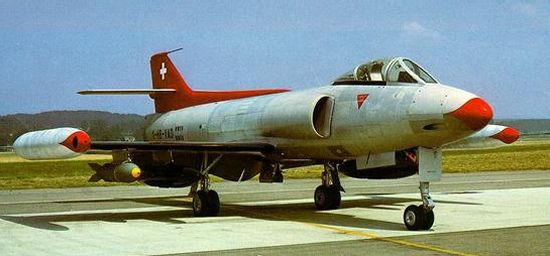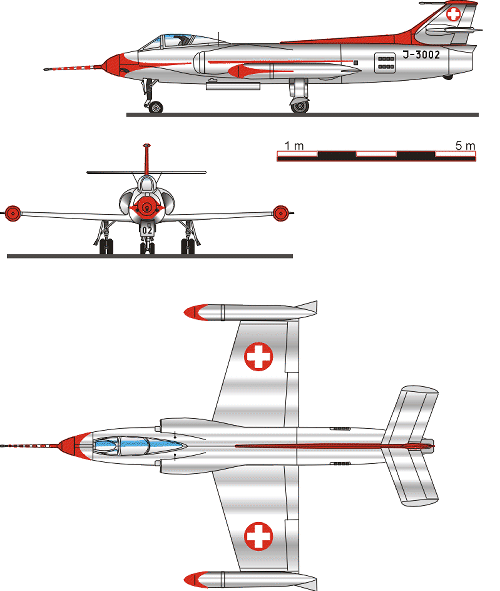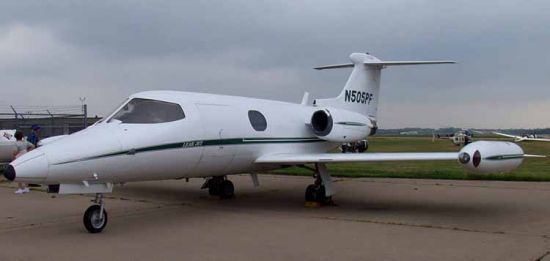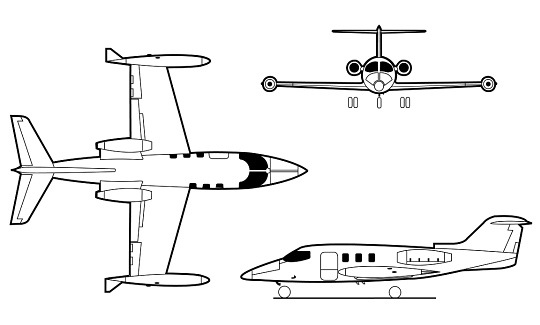|
||||||||||
|
|
||||||||||
|
||||||||||
|
|
||||||||||

Before getting into the specifics of the P-16 and how it led to the Learjet family, let's first take a step back and discuss the origins of the business jet. Executive aircraft began to appear in the early 1950s when many aircraft manufacturers started offering commercial airliners specifically tailored to corporate executives. Among these early innovators was William P. Lear, Sr., who first entered the market by converting surplus Lockheed Lodestars into elegant, streamlined, high-speed private aircraft under the name Learstar. While the Learstar and similar conversions proved a commercial success, their top speed was limited by the fact that they still used piston engines. The rapid development and availability of turbojet engines in the 1950s made possible a new generation of executive transports that could travel much faster at higher cruising altitudes than previously could be achieved. Many manufacturers from around the world soon overwhelmed the market with small private jets aimed at business executives.
However, Lear was convinced that a different kind of design philosophy could revolutionize the market. He believed that what business travelers wanted most was the highest cruising speeds and altitudes possible. To meet that need, he proposed minimizing aircraft size and weight while maximizing engine power to produce a lightweight aircraft with performance similar to that of a military fighter. Furthermore, keeping the weight under 12,500 lb (5,670 kg) would allow such a plane to be certified under the light aircraft category (Part 3) of the Federal Aviation Regulations in order to significantly reduce development time and costs. Lear also believed that costs could be further reduced by designing and manufacturing the aircraft in Europe where labor and material costs were lower. These bare airframes would then be shipped to the US for final assembly and delivery to customers. This plan led Lear to form the Swiss-American Aircraft Company (SAAC), based in Switzerland, in 1960.
Conveniently enough, the Swiss firm Flug-und Fahrzeugwerke AG, or FFA for short, was working on an interceptor/attack fighter for the Swiss Air Force at the time. The aircraft, known as the P-16, first flew in April 1955 and achieved supersonic flight for the first time in August 1956. The P-16 was a somewhat unconventional fighter for its day, more akin to the modern A-10 than its contemporaries. This unusual design was dictated by the peculiar needs of the Swiss Air Force, which demanded a plane capable of high transonic speeds, short takeoff and landing (STOL) capability from high altitude fields, good maneuverability, and a rapid climb rate when loaded for combat. FFA's resulting design featured a very thin straight wing, single-seat cockpit, and a single turbojet engine. Though it lacked the sleek aerodynamic lines of contemporaries like the F-104 or Mirage III, the P-16 performed remarkably well with a takeoff distance under 1,600 ft (490 m) and landing distance less than 1,000 ft (305 m) when using a drag parachute. This performance was made possible in large part by the design's strong, thin, high aspect ratio wing. One drawback of this very thin wing was the lack of internal volume for fuel, which made necessary the permanent wingtip fuel tanks that came to distinguish the design.

The Swiss government was sufficiently impressed that an order for 100 airframes was placed in 1958. Unfortunately, the crash of a prototype caused the order to be suspended. While the cause of the accident was a relatively minor defect in the hydraulic system that was easily corrected, the Swiss government remained convinced that the design was faulty and cancelled the order.
Nevertheless, the unusual fighter had not escaped the attention of Bill Lear in America. He was particularly impressed by the design's unswept, thin, high aspect ratio wing designed both for high subsonic cruise speeds and low landing speeds. The wing was also of very simple and inexpensive construction, combining an innovative and efficient layout of very few ribs, multiple spars, and a thick skin. Lear then approached the chief designer of FFA, Dr. Hans Studer, and proposed developing a new corporate jet around the wing of the P-16. The new plane was given the designation SAAC-23 after Lear's new company and the fact that this was Dr. Studer's third twin-jet design.
Further input, and the final design, was contributed by American aircraft designer Gordon Israel who had previously worked on the Learstar. Israel was responsible for the distinctive wedge-shaped nose of the SAAC-23 as well as the aircraft's overall sleek, stylish appearance. The clean, slender new fuselage was mated to a P-16 wing modified with a slightly thicker cross-section and greater span as well as a swept T-tail tailored for transonic flight. Powering the new aircraft were two General Electric J85 turbojet engines, already in use on the F-5 and T-38 supersonic aircraft, with a remarkable 7:1 thrust-to-weight ratio. All control, hydraulic, and electronic systems were kept as simple as possible to reduce costs and improve reliability.

Once design work had been completed, plans were put in place to begin assembly of the SAAC-23 in Europe. The wing and wingtip fuel tanks were to have been manufactured by FFA in Switzerland and the remainder of the airframe by Heinkel in Germany. After importing engines, landing gear, avionics, and other systems from the US, the aircraft would be assembled by FFA and then shipped to the US for finishing and delivery. While such multinational manufacturing techniques are commonplace today, this was not the case in 1961. The manufacturing program soon suffered numerous delays due to administrative hassles. Never a patient man, Lear decided to forego the overseas aspects of his manufacturing plan altogether and instead transferred all the tooling and material to Wichita, Kansas, in late 1962. Here, he opened the Lear Jet Corporation and renamed his introductory product the Lear Jet Model 23.
Making its first flight on 7 October 1963, the Learjet 23 was pushed through FAA certification in record time and achieved FAR Part 3 certification in July 1964. The initial target price of the new plane had been $350,000 in 1961, but the transfer from Europe and investment of $4 million into the Wichita factory had raised the cost to $575,000 for a fully equipped and furnished production model. Even so, this price was a full $150,000 cheaper than the Learjet's nearest competitor. In addition, the only other aircraft on the market that could match the Learjet's cruising speed was the Dassault Mystere 20, a much larger, heavier, and more expensive aircraft. The Learjet also offered a higher cruising altitude and initial climb rate than any other business jet, even surpassing that of many military fighters.
It is because of this improved performance and lower cost that the Learjet 23 quickly took the lead in the business jet market, garnering 94 orders by early 1965 alone. Soon thereafter, Lear began offering improved models that were larger with more cabin space and certified under the more stringent FAR Part 25 requirements. Yet even as the planes grew larger and more sophisticated, they retained the same basic design as the original Model 23 that had proven such a resounding success.

Bill Lear remained in control of his new company until April 1969 when he resigned over disagreements with his
business partners. Earlier, he had sold a controlling interest to the Gates Rubber Company in order to generate
new capital, and the company was renamed the Gates Learjet Corporation following Lear's departure. Today, Learjet
is owned by Bombardier in Canada, but many Learjet models are still being built. The first production Learjet 23
is now considered an historic aircraft and is in the collection of the National Air & Space Museum.
- answer by Joe Yoon, 28 September 2003
UPDATE!
We recently received an email from Richard Israel, son of Learjet designer Gordon Israel, who pointed out that the
original wing of the P-16 was more extensively redesigned for use on the SAAC-23 than implied in our article.
Although the overall planform shape remained largely the same, the internal structural layout of the wing was
completely revised.
- answer by Greg Alexander, 26 October 2003
Read More Articles:


|
Aircraft | Design | Ask Us | Shop | Search |

|
|
| About Us | Contact Us | Copyright © 1997-2023 | |||
|
|
|||